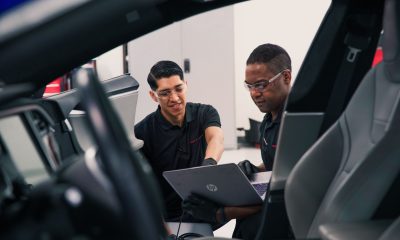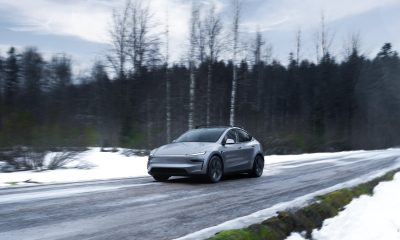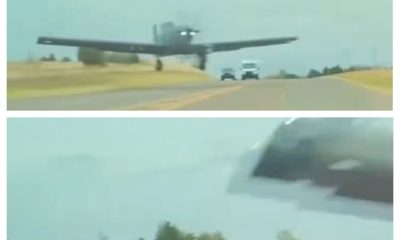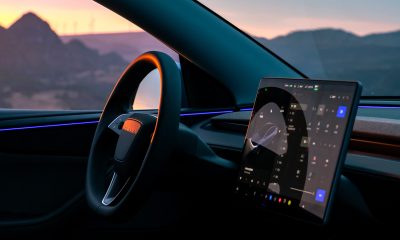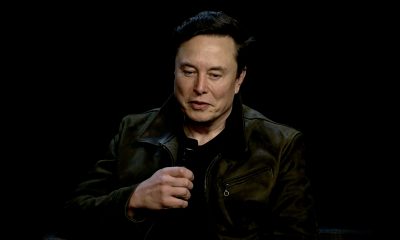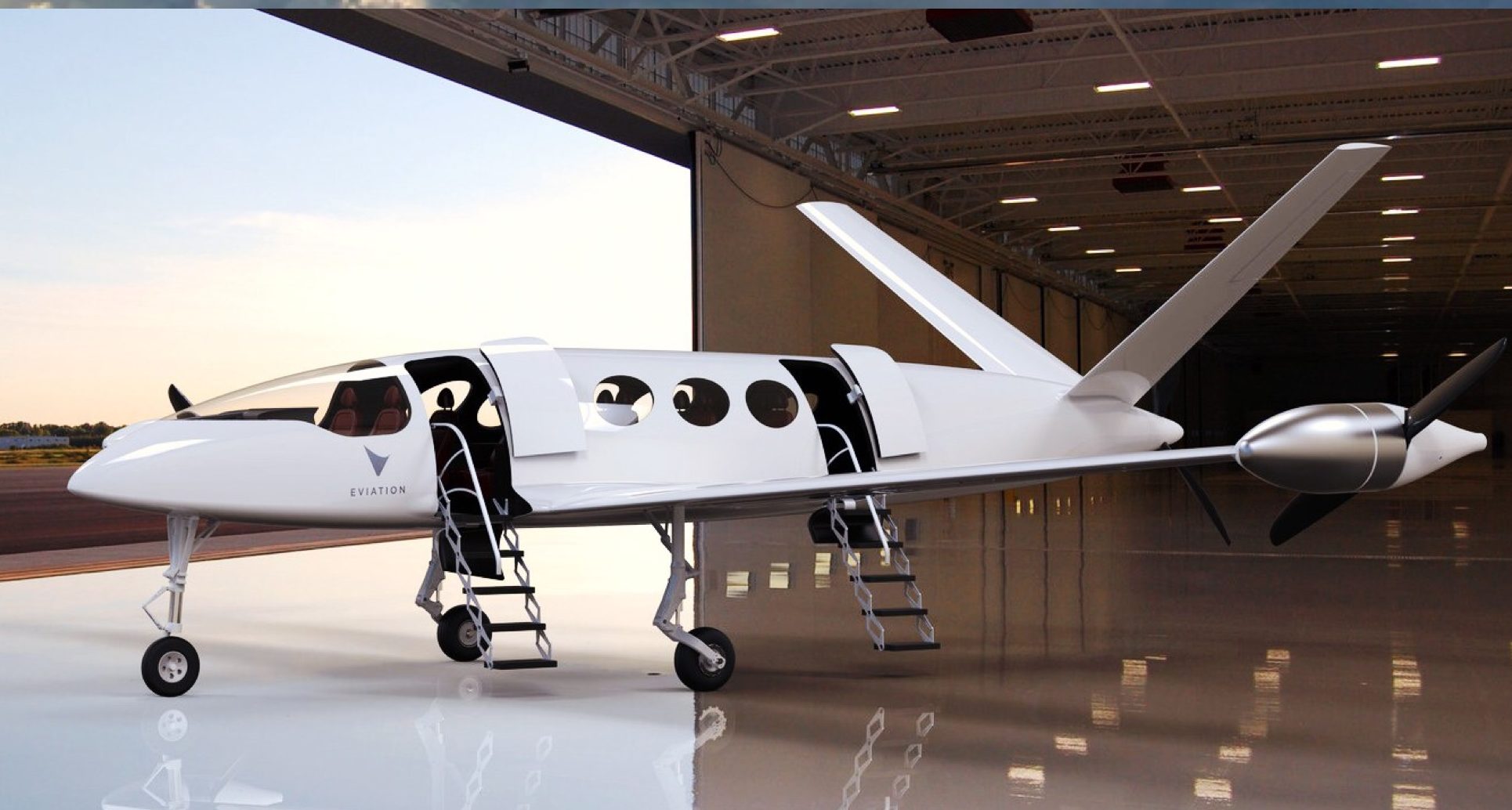
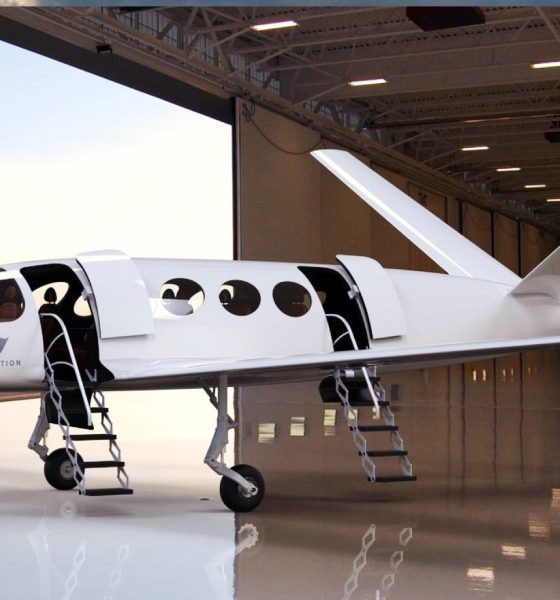
News
Tesla’s success ushers in a new era of electric flight
Electric flight may not be as far away as we once thought. In the next decade, aircraft are set to see dramatic changes as companies both large and small work to bring fully electric and hybrid flight to market. Airlines, manufacturers, and startups all seem to be moving towards this goal (see below). The race is clearly on and it will change the way we think about flight.
Yet as it was for the introduction of electric vehicles, the first aircraft is short range and seat just a few passengers. Their applications today are limited but to think the industry will stay in this nascent stage would be a mistake. Successes in these small and short-range aircraft will translate forward into larger and longer-range aircraft. The companies that find success here will emerge as leaders in a new era of electric flight.

Companies working on electric flight
On the Market Today:
First, it’s important to appreciate that only recently have small electric powered aircraft gone from concepts to commercial use.
Pipistrel’s Alpha Electro is one of these all-electric aircraft. It’s meant primarily for pilot training and just received its airworthiness certification from the FAA in April 2018, becoming the first in the USA to do so. The Alpha Electro only seats two people and is good for an hour of flight plus reserves. That might not sound like much but it could be disruptive. Pipistrel says the aircraft cuts beginner pilot training costs by as much as 70% while producing zero emissions and low noise.
In China, the Ruixiang RX1E is a similar style trainer sold there commercially. They also have a new, longer-range model that was recently tested, the RX1E-A. With a two-hour flight time the new version doubles its previous capabilities. At this size of aircraft the technology is getting close to parity with comparable gasoline-powered aircraft, like the Cessna 162 which has a flight time of about three hours.
Full parity might be here sooner than you think. Coming small electric aircraft have better specs and more seating, with many nearly ready for certification (pictured below). Pipistrel has their Panthera (top right), which will hold four passengers and will come in options for combustion, hybrid, and all-electric powertrains. There’s also BYE Aerospace in Colorado, which has a four-seater in development and just completed the first test flight of the two-seater Sun Flyer 2 — it has a flight time of 3 hours. Ruixiang also announced they have a 4-seater aircraft in development. The other important consideration is that their initial costs appear to be comparable to combustion options as well.
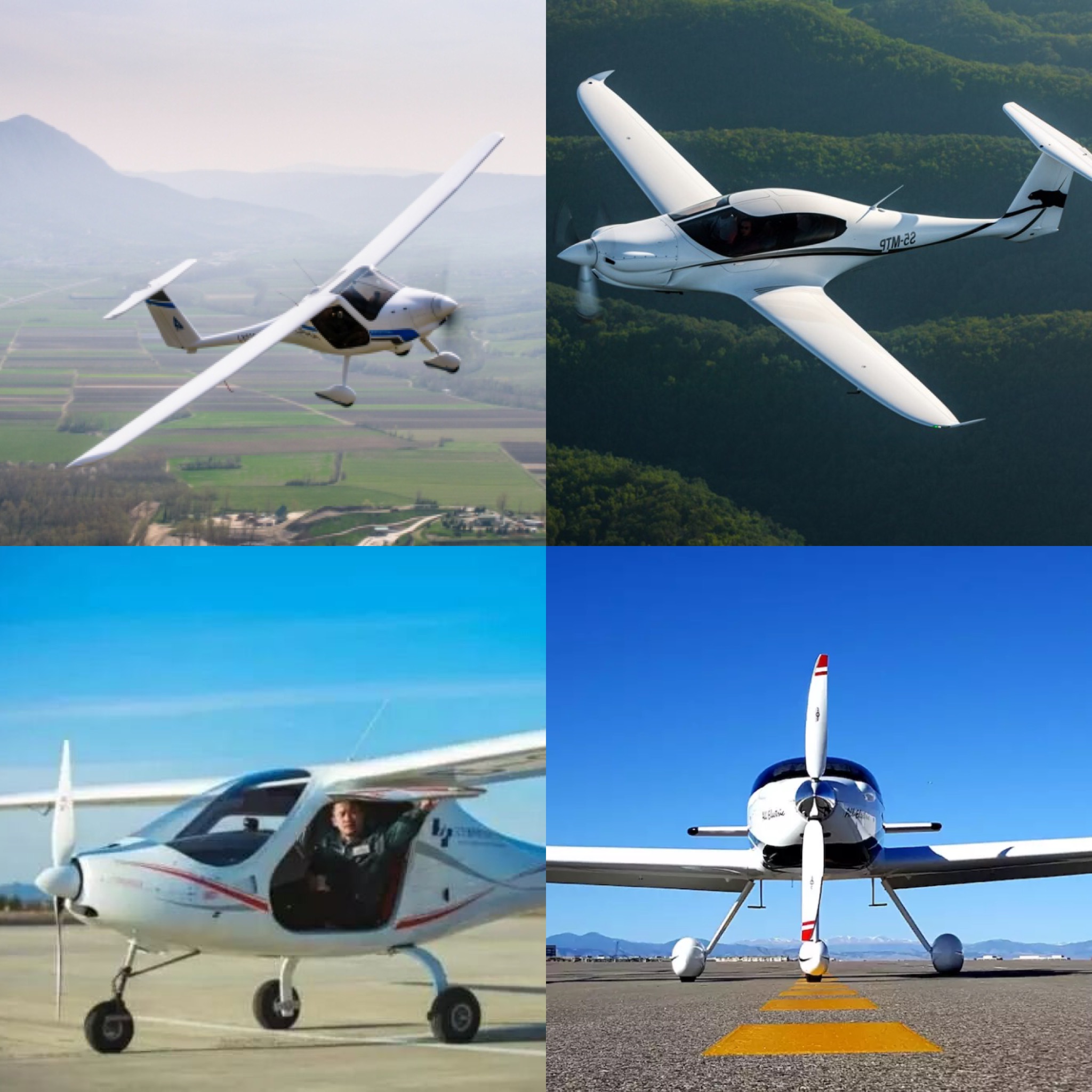
Pipistrel Alpha Electro (top left), Pipistrel Panthera (top right), Ruixiang RX1E-A (bottom left), BYE Aerospace Sunflyer 2 (bottom right)
Looking at these options, some will say that an electric aircraft is an isolated niche and for now, that’s mostly correct. These are small aircraft with limited applications. Yet when the Nissan Leaf and even the Tesla Roaster first came out many believed electric cars were a niche technology too. The range was too short, seating was too small, and costs were too high to realistically consider the technology going mainstream. Now we are in the midst of a market transformation, with automakers pouring billions into their EV programs and countries announcing they are phasing out combustion vehicles.
Market Transformation – Near-Term Preproduction:
The next major step for electric flight appears to be in small commuter aircraft. Aircraft that weigh less than 12,500 lbs, carry 5 to 20 passengers and travel up to 750 miles. In addition to regional commuter needs, they may also serve recreational and business purposes. If small aircraft are like the Tesla Roadster then these are like the Model S. They have more seats, longer range, and are made in higher volumes.
The use case of short range regional commuters is almost perfect for electrification. Much of their flight is spent just getting up to altitude, where cruising achieves the greatest efficiency. The time spent cruising however is relatively short and the result is that such regional flights are inherently less efficient than those over greater distances. On the plus side the high operating costs are a great opportunity for electrification. Consider that a turbine engine achieves an efficiency of around 55% at cruising, but on ascent that efficiency can drop by half (~25%). By comparison, an electric motor has efficiencies greater than 95%.
One of the companies working to electrify these regional aircraft is Wright Electric, based out of Los Angeles. They recently announced plans to bring to market a 9-seat electrified aircraft with a range of at least 340 miles. According to their website that would cover the distance of nearly 44% of all flights. The announcement is part of their new partnership with JetEx, a fixed-base operator based in Saudi Arabia with operations in over 30 countries. I recently spoke with Wright Electric’s CEO Jeff Engler about their coming aircraft and where he see’s the industry going. The first thing that surprised me is that their aircraft could be on the market very soon.
“We are certain that the first flight test will take place next year. It could be on the market in just over two years.” – Jeff Engler, CEO of Wright Electric
That means that sometime towards the end of 2020 or beginning of 2021 they could be in their air, operating with paying customers.
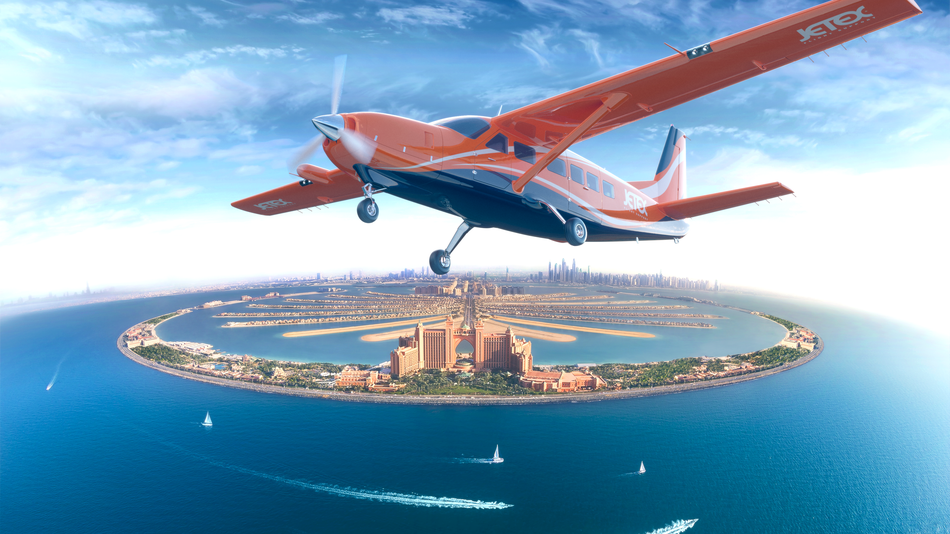
Wright Electric / JetEx
Their aircraft is intended for intercity travel and recreational activities Jeff said, but it’s not the end goal. In fact, their approach may be familiar to fans of electric cars.
“Our plan is similar to the Tesla approach, in the sense that they started with the Roadster and then scaled up to larger more mass market vehicles. Our first plane to market will be a premium aircraft meant to travel short distances with a small number of passengers… perfect for intercity flights and recreational activities like skydiving. This initial program is the springboard for development of larger longer-range aircraft”. – Jeff Engler, CEO of Wright Electric
In regards to the technology Jeff said they are developing the hybrid and all electric powertrains concurrently. He noted that battery advancements will dictate the transition to fully electric flight but in the interim, hybrid solutions will significantly reduce fuel costs, noise, and pollution. With restrained enthusiasm, he was cautiously optimistic about the coming advances in battery technology. Yet battery technology isn’t holding them up.
The beauty of hybrid options is that as batteries improve they can be seamlessly integrated into the design, allowing more of the flight to be electric. For their electric hybrid, Wright Electric likes to use the term “helper motor”. A helper motor can run hard during takeoff and ascent to help bring the aircraft up to altitude, thereby reducing the burden on the combustion engines, improving overall efficiency, and reducing fuel consumption. Once at altitude, the combustion engines can take over, where they operate most efficiently.
Even without being fully electric hybrid aircraft would have surprising benefits to fuel economy, pollution, and noise. Wright Electric has estimated the potential for reducing fuel use by nearly 2/3’s, while fellow electric aircraft startup Zunum Aero indicated 40% to 80% operating savings. Zunum Aero also noted a potential 70% reduction in community noise.
More Regional Commuter Aircraft are Coming Too:
Wright electric isn’t the only one working in this space. Other startups are also pushing the industry forward and they’ve partnered with established manufacturers and airlines to help make it happen. It’s similar to the approach Tesla took early on by partnering with established companies like Daimler and Toyota, and even in their recent developments of the Semi.
Zunum Aero is another one of the leaders in the electric aircraft space, based out of the west coast near Seattle. They are developing a 12-seat hybrid-electric, with a targeted range of over 700 miles. First test flights are targeted for 2019 and commercial operation is planned for 2022 (pictured below). Their partners include Boeing and JetBlue and just last week JetSuite announced they would order up to 100 of Zunum’s hybrid aircraft.
Eviation Aircraft is an Israel based company and has great ambitions for their first aircraft named “Alice”. It will be a 9-seat 650 mile aircraft and most importantly “all-electric”. They are targeting brining it to market by 2021. Is all-electric flight on that scale possible by 2021? They’ve said the aircraft will use a 950 kWh battery and just recently signed Kokam as their battery supplier, so they seem to be serious. I hope they make it happen. Alice is gorgeous.
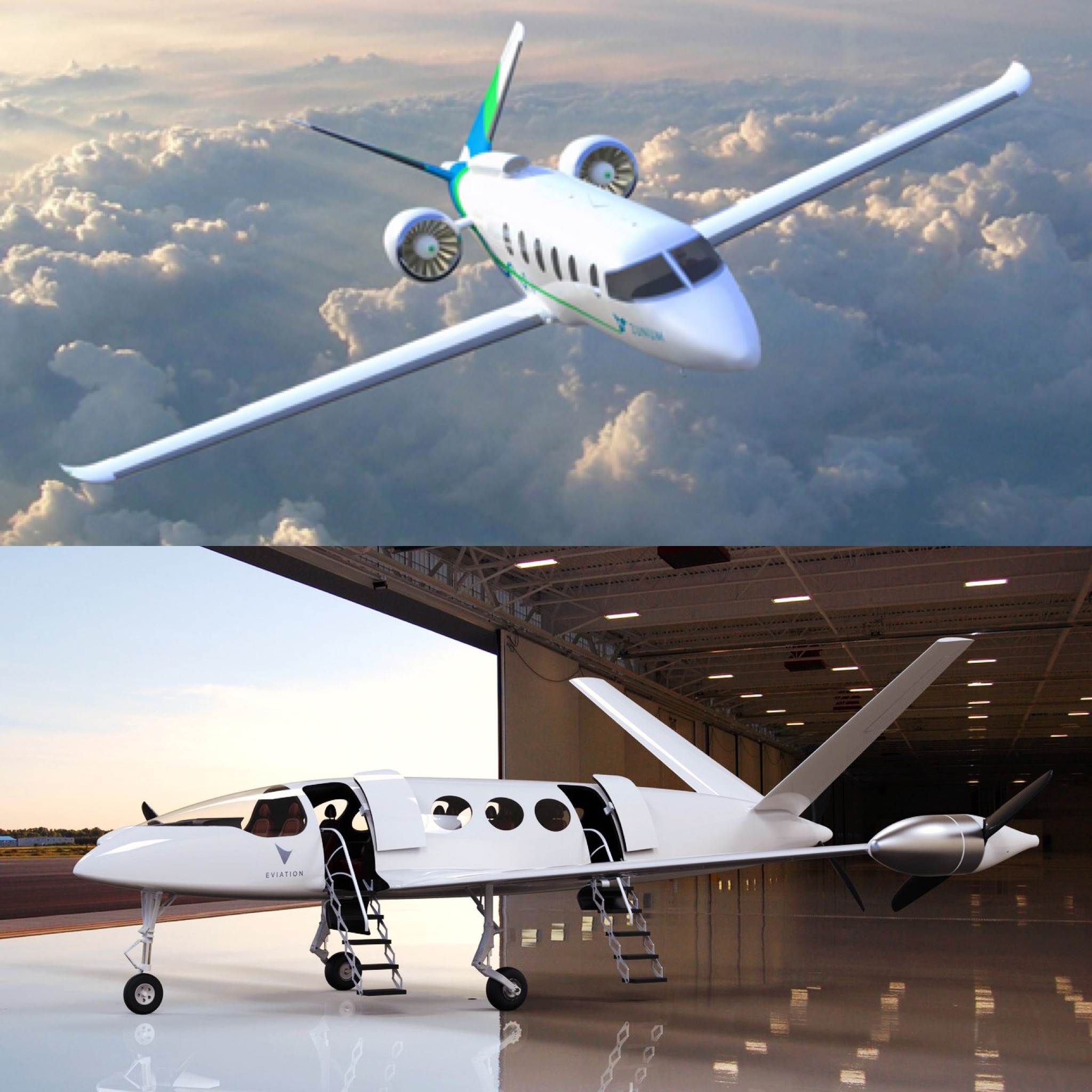
Zunum Aero (top), Eviation Aircraft (bottom)
Other Exciting Developments Coming Soon:
In the heavyweight division Airbus, Siemens, and Rolls-Royce have their own partnership, working together on their E-Fan X after the successful small electric E-Fan program. The E-Fan X will be a hybrid demonstrator aircraft based on the 100-seat BAe146. The first test flight is planned for 2020 and they are looking to bring a similarly sized hybrid aircraft to market sometime around 2030. Originally they were going to bring a small electric trainer based on the E-Fan to market in 2017 or 2018 but said the pace of development has set their ambitions upwards. There’s also Airbus’s subsidiary A3 which is working on a small all-electric vertical takeoff and landing aircraft.
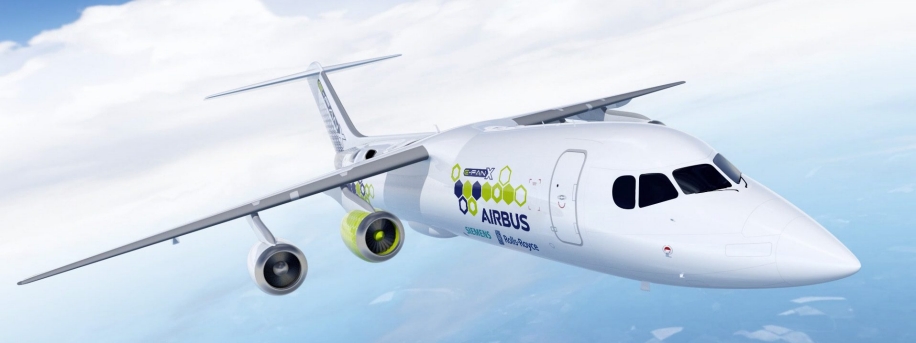
E-Fan X
Vertical takeoff and landing aircraft are extremely interesting. They could be the biggest disrupters of all (covered in more detail in a follow up article, part 2). They too seem to be much closer than people think. For flying short distances they don’t actually need massive advancements in battery technology. Norway’s Avinor, their national aircraft operator, seems to indicate the mid 2020’s for practical operation.
Companies like Uber, Lilium, Kittyhawk, A3, and many more are developing electric aircraft capable of vertical takeoff and landing. They look more like flying cars than airplanes and that seems to be the point. These “air-taxis” are meant for hyper-local travel. Something you would hop onto downtown and take to get to across the city or to another nearby city. Lilium is a relatively new startup, founded in 2015, but has already made significant advancements in the space. They’ve already had their first full-scale test flight which is viewable below. Watching it lift off is almost magical. They brought on former Ferrari designer Frank Stephenson to head their design program and raised $90M to proceed with further development.
Lilium VTOL
Final Thoughts and Intro to Part 2
For fully electric flight a lot depends on batteries, but the technology is already finding applications in short-range, small aircraft. Increasing larger hybrid aircraft are also set to see their application in the real world in just a few years and will yield substantial benefits of their own. These moves should not be discounted. They are a prelude of what’s to come.
At this point, you may be wondering exactly what are the benefits of electric flight. That’s the focus of the second part of this article, coming out soon. They are substantial and will drive the industry forward with haste.
News
Tesla makes a massive change to a Service policy that owners will love
If you have a subscription to Full Self-Driving or Premium Connectivity for 30 days, the date of its expiration is 30 days after you activate the subscription, even if the vehicle was in service.
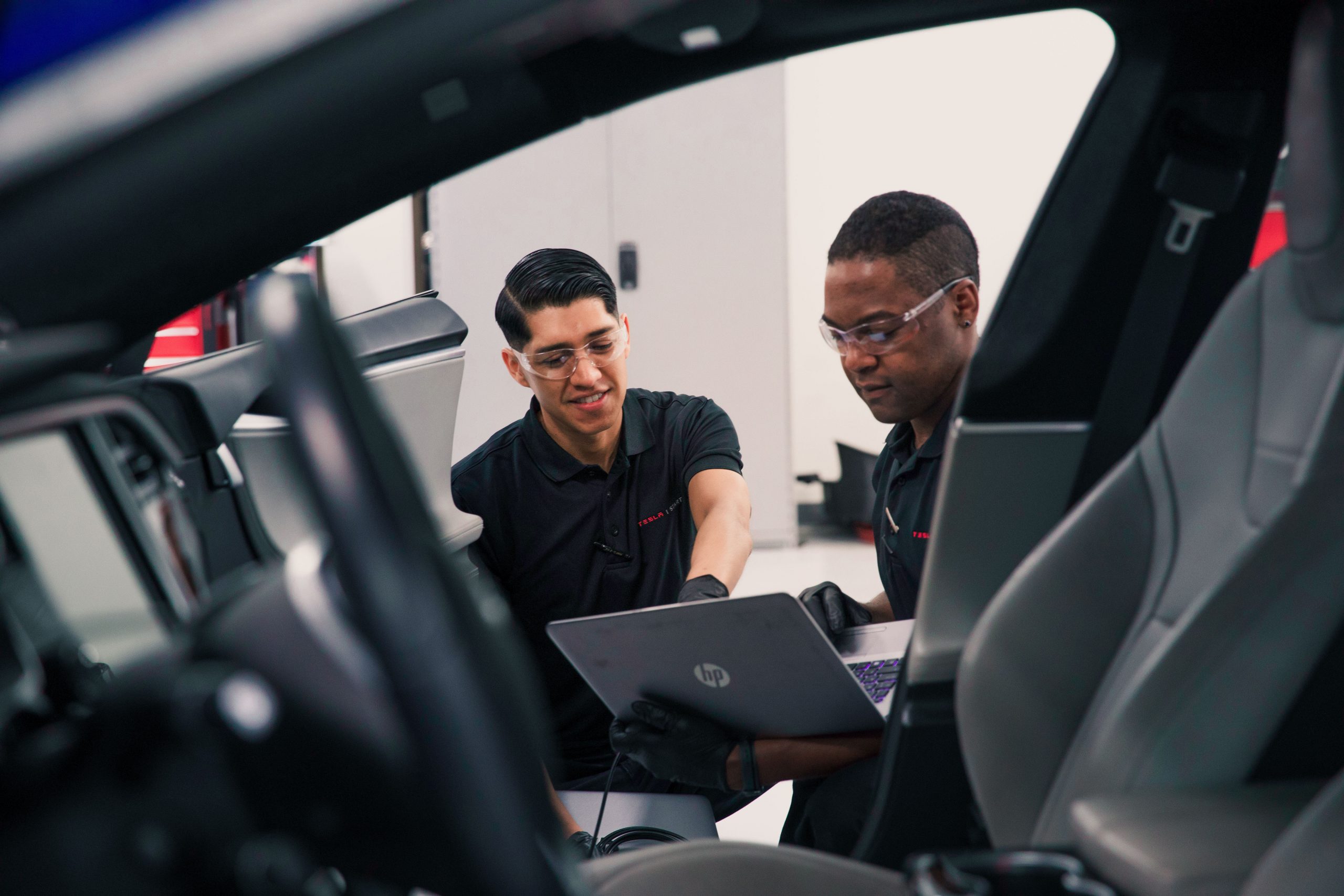
Tesla has decided to update its policy on Subscriptions and Service, and owners are going to love it.
If you have a subscription to Full Self-Driving or Premium Connectivity for 30 days, the date of its expiration is 30 days after you activate the subscription, even if the vehicle was in service.
So, if your car was with Tesla Service for five days, you essentially lost those five days, as your expiration date was not adjusted to reflect the time the vehicle was unusable.
Loaners that Tesla gives owners are usually equipped with perks like Full Self-Driving and Premium Connectivity, so your subscription does not roll over to another vehicle.
However, Tesla has decided to revise that policy in an effort to give owners full access to the subscriptions they paid for. It requires Service visits to be longer than one day.
In a communication to an owner who was having their vehicle serviced, Tesla said:
“A loaner vehicle may be available during your appointment (pending availability) – please check the app closer to your appointment for the latest updates and access details. If your repair requires more than one business day, any active subscriptions or free trials will be extended accordingly.”
Tesla will now extend active subscriptions and free trials if your car was in service for more than 1 business day pic.twitter.com/HdtDEwk3e6
— Whole Mars Catalog (@WholeMarsBlog) October 20, 2025
The move is a good one from a customer service standpoint, especially considering the loss of even a few days of a 30-day subscription to something like Full Self-Driving, which costs $99 per month, can be frustrating.
Tesla’s choice to extend the subscription duration for the length of the service visit is a good-faith move that customers will appreciate.
While this adjustment is not directly related to Service, many customers will relate it to that. It’s yet another move Tesla has made in 2025 to make its Service experience better for customers.
It is also offering more options to communicate with Service advisors during and after cars are repaired, which can help streamline the entire visit from start to finish.
News
SpaceX reaches incredible Starlink milestone
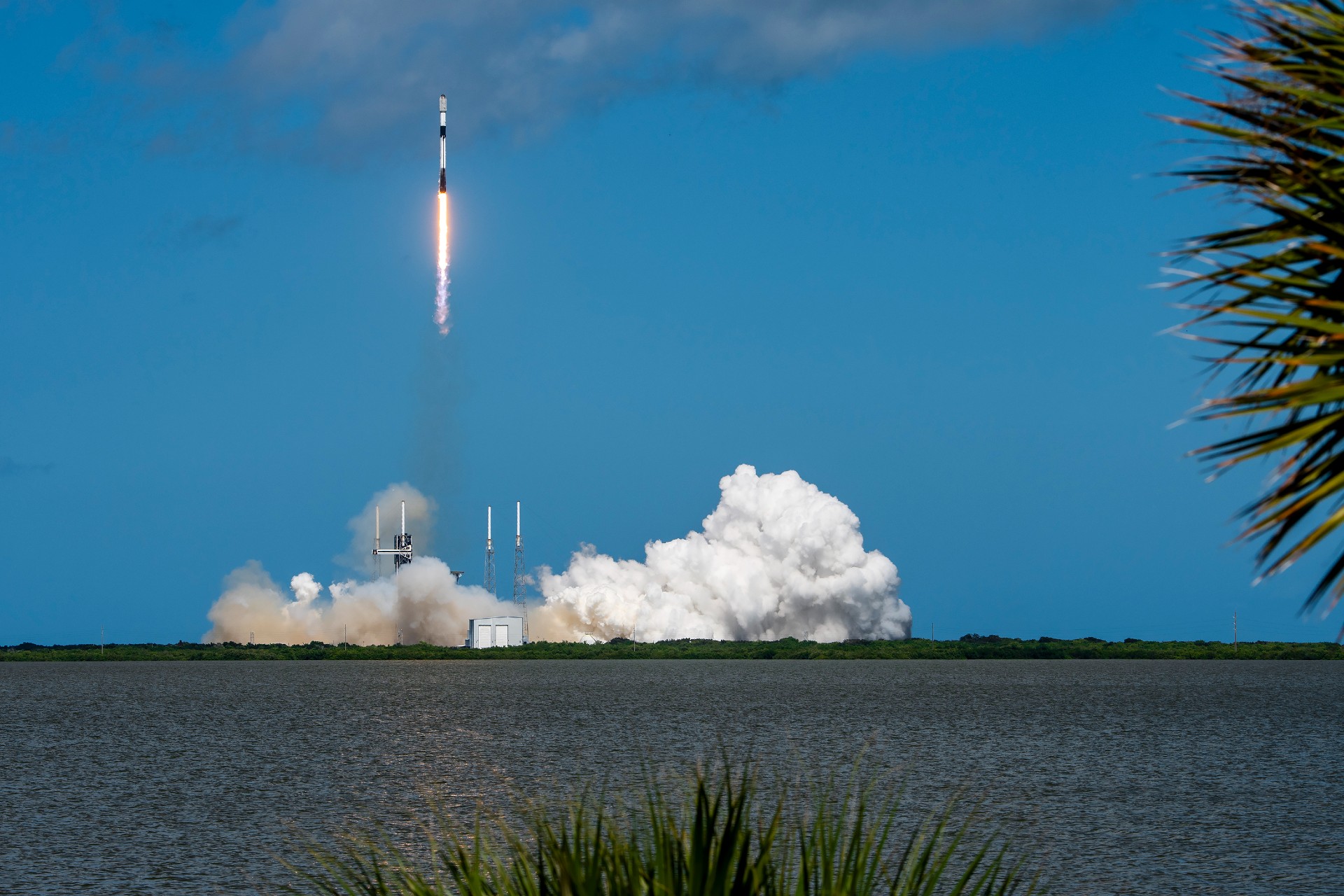
SpaceX has reached an incredible milestone with its Starlink program, officially surpassing 10,000 satellites launched into low Earth orbit since starting the program back in 2019.
Last Sunday, October 19, SpaceX launched its 131st and 132nd Falcon 9 missions of 2025, one from Cape Canaveral, Florida, and the other from Vandenberg, California.
The 10,000th Starlink satellite was aboard the launch from California, which was Starlink 11-19, and held 28 v2 mini optimized satellites.
The achievement was marked by a satellite tracker developed by Jonathan McDowell.
🚨 With its Falcon 9 launch last Sunday, SpaceX officially has 10,000 Starlink satellites in orbit pic.twitter.com/xS5RVZ4ix0
— TESLARATI (@Teslarati) October 26, 2025
The first Starlink launch was all the way back on May 23, 2019, as SpaceX launched its first 60 satellites from Cape Canaveral using a Falcon 9 rocket.
Of the over 10,000 satellites in orbit, the tracker says 8,608 are operational, as some are intentionally de-orbited after becoming faulty and destroyed in the atmosphere.
SpaceX has truly done some really incredible things during its development of the Starlink program, including launch coverage in a global setting, bringing along millions of active subscribers that use the service for personal and business use, locking up commercial partnerships, and more.
Starlink currently operates in around 150 countries, territories, and markets and is available at least somewhere on all seven continents.
Additionally, Starlink has over 5 million subscribers worldwide, and 2.7 million have joined the program over the past year. It has revolutionized internet access on commercial aircraft as well, as several high-profile airlines like Qatar and United, among many others, have already installed Starlink on some of their planes to deliver more stable connectivity for passengers and crew.
SpaceX has the approval to launch 12,000 Starlink satellites from the FAA, but it plans to bring over 30,000 to its constellation, giving anyone the ability to have access to high-speed internet.
News
Tesla Full Self-Driving’s biggest improvements from v13 to v14

Tesla Full Self-Driving (Supervised) v14 has been out for several weeks now, and there are a tremendous number of improvements, as we have now reached the fourth iteration of the semi-autonomous software.
Tesla began the v14.1.4 launch last night, which included minor improvements and addressed brake-stabbing issues many owners have reported. In my personal experience, the stabbing has been awful on v14.1.3, and is a major concern.
However, many things have improved, and only a couple of minor issues have been recurring. Many of the issues v13 addressed are no longer an issue, so Tesla has made significant progress.
Here are some of the most notable improvements Tesla made with v14 from v13:
Better Lane Switching on Highways
One of my biggest complaints with v13 was that the “Hurry” Speed Profile would often stay in the left lane, even when there were no passing cars. The legality of cruising in the left lane fluctuates by jurisdiction, but my personal preference is to drive in the right lane and pass on the left.
That said, Tesla has improved FSD’s performance with more courteous lane behavior. It no longer camps in the left lane and routinely gets back in the right lane after passing slower cars.
More Awareness for Merging Traffic and Makes Courteous Moves
There have been times when FSD has been more aware of merging traffic, and even cross traffic, than most human beings.
Here are a few examples –
- Full Self-Driving lets a car out of cross traffic during a busy time of day. This road tends to get very congested, especially during rush hour, so the car that was let in by FSD would have been sitting there for likely a minute longer if my Tesla had not let him in:
When you realize Tesla Full Self-Driving is more courteous than most human drivers… pic.twitter.com/PnKJcTpwKu
— TESLARATI (@Teslarati) October 26, 2025
- A busy, four-lane expressway with a quick exit on the far side of the highway for this merging vehicle. I’ve seen some drivers be extremely inattentive and travel at the same speed as merging cars, making their entry onto the expressway less seamless. FSD doesn’t do that; it makes way for merging cars:
— Joey Klender (@KlenderJoey) October 26, 2025
More Confident Driving Around Mail Trucks…and Amish
I encounter a lot of Amish in my area of Pennsylvania, and they commonly use both shoulders and the road, so traffic can get congested at times.
In the past, I’ve taken over when encountering Amish buggies, mail trucks, or other vehicles that are moving slowly or making frequent stops. I have felt it is more logical to just take over in these situations.
I decided not to yesterday on a long drive through Lancaster, PA, and the FSD did a wonderful job of confidently overtaking these vehicles:
Let’s see how Tesla Full Self-Driving v14.1.3 handles Amish traffic
Used Dashcam for these; no GoPro in the car today pic.twitter.com/ZYxrBXD9nZ
— TESLARATI (@Teslarati) October 25, 2025
This was really impressive and fun to see. There was a slight stutter during one of the three instances, but overall, I didn’t have any concerns.
Object Avoidance
On v13, I almost let the car drive into a fallen branch in the middle of the road. A mile later, the car swerved out of the way for horse droppings. It was a beautiful, clear morning, and the fact that the car did not try to avoid the branch, but did steer away from poop, was concerning.
Tesla has obviously done a great job at refining FSD’s ability to navigate around these road hazards. Last night, it swerved around a dead animal carcass in the middle of the highway. I didn’t see it until we were already going around it:
Some more Tesla Dashcam footage that was very impressive – v14.1.3:
✅ Swerved to avoid an animal carcass on the highway
✅ Consideration move to allow a car to mergeDashcam weirdly makes things look slower than they actually occurred. These both were enough for me to hit the… pic.twitter.com/CjmYLOBMQU
— TESLARATI (@Teslarati) October 26, 2025
It was awesome to see this and never feel alarmed by the sharp movement. The maneuver was smooth and really well done.
Better Speed Consistency
With v13, I felt I had to constantly adjust the Speed Profile, as well as the Max Speed setting, when using FSD. With V14, I don’t feel like I am making as many adjustments.
Tesla axed the Max Speed setting altogether with v14, which was a good move, in my opinion. Choosing the Speed Profile is now more intuitive by using the right scroll wheel. If the car is traveling too fast or too slow, just change the profile.
Three things Tesla needs to improve with Full Self-Driving v14 release
V13 had some issues with local roads, and I felt it would travel at strange speeds. In a 45 MPH zone, it would sometimes take a long time to reach 40 MPH, then hover between 43 MPH and 47 MPH. It would then fluctuate between those two speeds, frustrating drivers behind me, understandably.
V14 gets up to speed much better and travels at speeds I’m much more comfortable with on both local roads and highways.
-

 Elon Musk1 week ago
Elon Musk1 week agoSpaceX posts Starship booster feat that’s so nutty, it doesn’t even look real
-

 Elon Musk1 week ago
Elon Musk1 week agoTesla Full Self-Driving gets an offer to be insured for ‘almost free’
-

 News1 week ago
News1 week agoElon Musk confirms Tesla FSD V14.2 will see widespread rollout
-

 News1 week ago
News1 week agoTesla is adding an interesting feature to its centerscreen in a coming update
-

 News2 weeks ago
News2 weeks agoTesla launches new interior option for Model Y
-

 News1 week ago
News1 week agoTesla widens rollout of new Full Self-Driving suite to more owners
-

 Elon Musk1 week ago
Elon Musk1 week agoTesla CEO Elon Musk’s $1 trillion pay package hits first adversity from proxy firm
-

 News1 week ago
News1 week agoTesla might be doing away with a long-included feature with its vehicles


